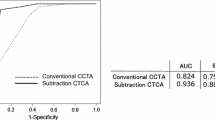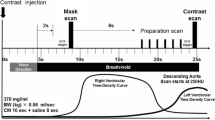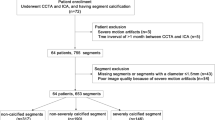Abstract
Purpose
To investigate the feasibility and diagnostic accuracy of subtraction CTA on patients with highly calcified coronary artery disease (CAD) or previous implanted stents, in comparison with invasive coronary angiography (ICA).
Materials and methods
Twenty-three patients were recruited. All conventional and subtraction CTA exams were performed using a 320-row CT. Subjective image quality score was assessed for each segment using a 4-point scale: 1-uninterpretable to 4-good image quality.
Results
A total of 129 calcified or stented coronary segments were studied. Mean coronary image quality with conventional CTA was 2.73 ± 0.97 and in subtracted CTA 3.3 ± 0.92 (p < 0.01). After metal subtraction, image quality in stented coronary segments with >3 mm of diameter improved from 2.69 ± 0.97 to 3.34 ± 0.89 (p = 0.01) and in those with <3 mm of diameter from 2.11 ± 0.78 to 2.67 ± 0.87 (p = 0.17). There was an improvement in diagnostic accuracy to detect ICA stenosis >50 % by subtraction CTA compared with conventional CTA (AUC 0.93 to 0.87; p = 0.02).
Conclusion
Subtraction CTA is promising in overcoming limitations of conventional CTA due to calcium or metal artefacts, especially if no motion artefact is present or when stents > 3 mm are studied.
Key Points
• Calcium and metal artefacts are still a limitation for conventional coronary CTA
• Diagnostic accuracy is improved by subtraction as compared with conventional CTA
• Subtraction CTA is a promising tool to overcome limitations of conventional CTA





Similar content being viewed by others
References
Members TF, Montalescot G, Sechtem U, Achenbach S, Andreotti F, Arden C et al (2013) 2013 ESC guidelines on the management of stable coronary artery disease: the Task Force on the management of stable coronary artery disease of the European Society of Cardiology. Eur Heart J 34:2949–3003
Hamm CW, Bassand J-P, Agewall S, Bax J, Boersma E, Bueno H et al (2011) ESC Guidelines for the management of acute coronary syndromes in patients presenting without persistent ST-segment elevation: the Task Force for the management of acute coronary syndromes (ACS) in patients presenting without persistent ST-segment elevatio. Eur Heart J 32:2999–3054
Stolzmann P, Scheffel H, Leschka S, Plass A, Baumüller S, Marincek B et al (2008) Influence of calcifications on diagnostic accuracy of coronary CT angiography using prospective ECG triggering. AJR Am J Roentgenol 191:1684–1689
Vavere AL, Arbab-Zadeh A, Rochitte CE, Dewey M, Niinuma H, Gottlieb I et al (2011) Coronary artery stenoses: accuracy of 64–detector row CT angiography in segments with mild, moderate, or severe calcification—a subanalysis of the CORE-64 trial. Radiology 261:100–108
Abdulla J, Pedersen KS, Budoff M, Kofoed KF (2012) Influence of coronary calcification on the diagnostic accuracy of 64-slice computed tomography coronary angiography: a systematic review and meta-analysis. Int J Cardiovasc Imaging 28:943–953
Meijboom WB, van Mieghem C a G, Mollet NR, Pugliese F, Weustink AC, van Pelt N et al (2007) 64-slice computed tomography coronary angiography in patients with high, intermediate, or low pretest probability of significant coronary artery disease. J Am Coll Cardiol 50:1469–1475
Yan RT, Miller JM, Rochitte CE, Dewey M, Niinuma H, Clouse ME et al (2013) Predictors of inaccurate coronary arterial stenosis assessment by CT angiography. JACC Cardiovasc Imaging 6:963–972
Park HB, Lee BK, Shin S, Heo R, Arsanjani R, Kitslaar PH et al (2015) Clinical Feasibility of 3D Automated Coronary Atherosclerotic Plaque Quantification Algorithm on Coronary Computed Tomography Angiography: Comparison with Intravascular Ultrasound. Eur Radiol 25:3073–3083
Rixe J, Achenbach S, Ropers D, Baum U, Kuettner A, Ropers U et al (2006) Assessment of coronary artery stent restenosis by 64-slice multi-detector computed tomography. Eur Heart J 27:2567–2572
Andreini D, Pontone G, Bartorelli AL, Mushtaq S, Trabattoni D, Bertella E et al (2011) High diagnostic accuracy of prospective ECG-gating 64-slice computed tomography coronary angiography for the detection of in-stent restenosis: In-stent restenosis assessment by low-dose MDCT. Eur Radiol 21:1430–1438
Dewey M, Zimmermann E, Deissenrieder F, Laule M, Dübel H-P, Schlattmann P et al (2009) Noninvasive coronary angiography by 320-row computed tomography with lower radiation exposure and maintained diagnostic accuracy: comparison of results with cardiac catheterization in a head-to-head pilot investigation. Circulation 120:867–875
De Graaf FR, Schuijf JD, van Velzen JE, Kroft LJ, de Roos A, Reiber JHC et al (2010) Diagnostic accuracy of 320-row multidetector computed tomography coronary angiography in the non-invasive evaluation of significant coronary artery disease. Eur Heart J 31:1908–1915
Tanaka R, Yoshioka K, Muranaka K, Chiba T, Ueda T, Sasaki T et al (2013) Improved evaluation of calcified segments on coronary CT angiography: a feasibility study of coronary calcium subtraction. Int J Cardiovasc Imaging 29:75–81
Hausleiter J, Meyer T, Hermann F, Hadamitzky M, Krebs M, Gerber TC et al (2009) Estimated radiation dose associated with cardiac CT angiography. JAMA 301:500–507
Agatston AS, Janowitz WR, Hildner FJ, Zusmer NR, Viamonte M, Detrano R (1990) Quantification of coronary artery calcium using ultrafast computed tomography. J Am Coll Cardiol 15:827–832
Austen WG, Edwards JE, Frye RL, Gensini GG, Gott VL, Griffith LS et al (1975) A reporting system on patients evaluated for coronary artery disease. Report of the Ad Hoc Committee for Grading of Coronary Artery Disease, Council on Cardiovascular Surgery, American Heart Association. Circulation 51:5–40
MEMBERS WC, Budoff MJ, Cohen MC, Garcia MJ, Hodgson JM, Hundley WG et al (2005) ACCF/AHA clinical competence statement on cardiac imaging with computed tomography and magnetic resonance: a report of the American College of Cardiology Foundation/American Heart Association/American College of Physicians Task Force on Clinical Competenc. Circulation 112:598–617
Zou KH, O’Malley AJ, Mauri L (2007) Receiver-operating characteristic analysis for evaluating diagnostic tests and predictive models. Circulation 115:654–657
Yoshioka K, Tanaka R, Muranaka K (2012) Subtraction coronary CT angiography for calcified lesions. Cardiol Clin 30:93–102
Geleijns J, Joemai RMS, Dewey M, De Roos A, Zankl M, Cantera AC et al (2011) Radiation exposure to patients in a multicenter coronary angiography trial (CORE 64). AJR Am J Roentgenol 196:1126–1132
Acknowledgments
This study has been performed with technological support from Toshiba Medical Systems- Spain. The scientific guarantor of this publication is Dr. David Viladés Medel. The authors of this manuscript declare no relationships with any companies, whose products or services may be related to the subject matter of the article. The authors state that this work has not received any funding. One of the authors has significant statistical expertise (DVM). Institutional Review Board approval was obtained. Written informed consent was obtained from all subjects (patients) in this study. Approval from the institutional animal care committee was not required.
Methodology: prospective, diagnostic study / performed at one institution.
Author information
Authors and Affiliations
Corresponding author
Rights and permissions
About this article
Cite this article
Viladés Medel, D., Leta, R., Alomar Serralach, X. et al. Reliability of a new method for coronary artery calcium or metal subtraction by 320-row cardiac CT. Eur Radiol 26, 3208–3214 (2016). https://doi.org/10.1007/s00330-015-4130-4
Received:
Revised:
Accepted:
Published:
Issue Date:
DOI: https://doi.org/10.1007/s00330-015-4130-4




